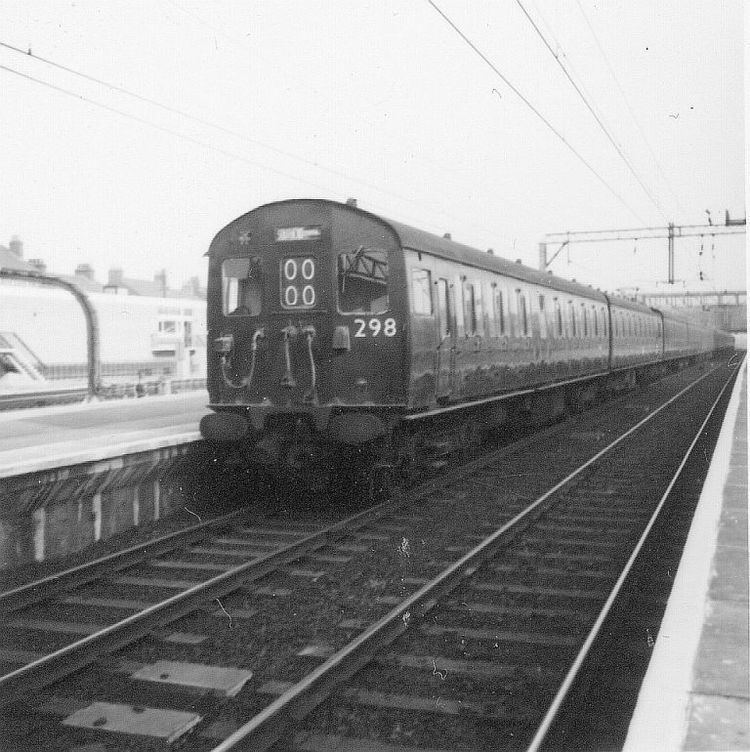In service 1958 - 1999 Formation 4 Cars per Trainset | Number built 112 trainsets Capacity 344 seats | |
 | ||
Manufacturer BR York Works and Doncaster Refurbishment 1981 - 1982 (All)1992 (3 mail conversions) | ||
The British Rail Class 302 (pre-TOPS AM2) was a type of electric multiple unit (EMU) introduced between 1958 - 1960 for outer suburban passenger services on the London, Tilbury and Southend Railway route. This class of multiple unit was constructed using the Mark 1 bodyshell and was slam-door.
Contents
Service History
Each unit was formed of four coaches in the formation BDTS - MBS - TC - DTS. The initial set numbers were 201-312, later prefixed by the class number 302.
They were among the first 25 kV units delivered to the Eastern Region, and although ordered for the LT&S electrification, which route they were long associated with, they were used initially on the Liverpool Street to Southend Victoria line from the day this was converted from DC to AC power, covering the period while the former DC units were rebuilt to AC. The first 20 units remained on the GE main line for the bulk of their lives, with the remainder operating on the LT&S from Fenchurch Street from 1962.
Like all the Eastern Region AC EMUs of the period, they were equipped to operate on both 25 kV AC and the reduced 6.25 kV voltage in the inner London areas where headroom for the overhead wires was reduced. On the LT&S the changeover point was just east of Barking station on both Upminster and Tilbury routes.
Trailer coaches were originally fitted with Gresley bogies which were replaced on Driving Trailer (DT) and Trailer Standard Open (TSO) which was formerly Composite Trailer and B5 Bogies on Battery Driving Trailer which became Battery Composite Trailer, the refurbishment moved First class accommodation to a position over the Westinghouse CM38 main compressor which was noisy and caused vibration. The Motor Coach retained its Gresley derived bogies after refurbishment.
The Battery Driving Trailer and Driving Trailer were fitted with drop head buckeye couplers with screw coupler in the Guards Van, retractable buffers are also fitted only on outer ends of the Battery Driving Trailer/Driving Trailer.
Originally the vehicles were insulated with "blue" asbestos which was removed and sealed during refurbishments.
Unit 302 244 was involved in an accident with a lorry at a level crossing at Low Street railway station in Tilbury, after which it was decided to scrap the leading carriage. This was replaced with a carriage originally belonging to a Manchester-Bury Line Class 504.
Following the privatisation of British Rail, the units passed to LTS Rail in 1996.
The class was fully withdrawn from service in 1999 due to the age of the units, with some being 40 years old. They were replaced by Class 310 units, Class 312 units, and Class 317 units, the latter of which were on loan from WAGN.
Electrical Equipment
Electrical equipment was supplied by English Electric with the majority of equipment being interchangeable with Class 308 units.
Electrically there were three main systems, Control which operated at 110 volts DC, provided by nickel iron alkaline secondary cells, auxiliary 250 volts AC from the tertiary winding of the main transformer which provided power to the battery charger which was also rectified to power the main compressor, and finally power circuits derived from secondary winding of the main transformer at 1,500 volts AC.
The primary winding of the transformer was designed to operate on either 6.25 kV or 25 kV with voltage sensing equipment fitted to ensure the correct arrangement of primary windings for a given voltage. An incorrect voltage selection device was fitted to both the Class 302 and Class 308 stock so that if the primary winding was connected for 6.25 kV when supplied with 25 kV the air blast circuit breaker (ABB) manufactured by ABB Asea Brown Boveri would remain closed but the pantograph would be lowered. Should this happen the transformer would require changing and overhaul as well as possibly other equipment due to flashover damage.
The transformer was also protected by a Buchholz relay which monitored any gas build-up within the cooling/insulating oil, as the acetylene (ethyne) gas generated is highly explosive. All Class 302 and 308 stock were fitted with Stone Faiveley pantographs for current collection from the overhead line. A particular oddity of Eastern/Anglian region EMU stock was the fitting of fibre glass snow shields between the pantograph and the supporting insulators.
One member of the class, 302 302, was experimentally fitted with thyristor control in the early 1970s. After the experiment it was converted back to the original tap changer control, although the guard's van remained slightly different internally.
Class 302/9 - non-passenger conversions
The sub-classification 302/9 was used for six non-passenger carrying conversions. Units 302990-992 were reduced to three-car length and converted for use as Royal Mail parcels units, with the addition of bodyside roller shutter doors, and repainted in Royal Mail red livery. Units 302996-998 were also reduced to three-car length and used as departmental sandite rail treatment units, later being reclassified as Class 937.
Preservation
Two driving trailers No. 75033 and No. 75250 carriages which belonged to units 302 201 and 302 227 are preserved at Mangapps Farm Railway Museum near Burnham-on-Crouch, Essex. These units have been repainted into BR overall blue with yellow ends and are still in very good condition with the destination scrolls still in working order, the seats still in British Rail colours, and the Network South East maps still in very good condition. The rest of the fleet has been scrapped since withdrawal in late 1999.
